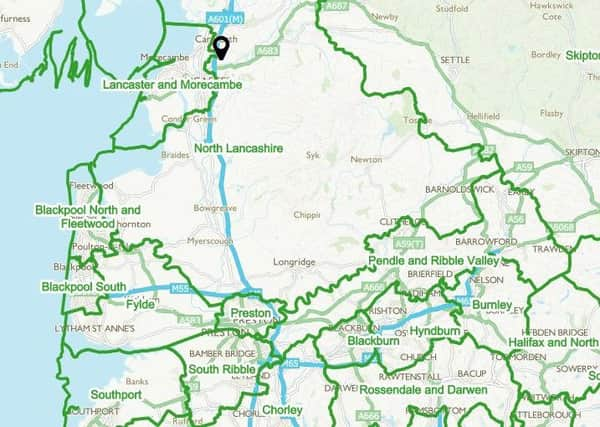One MP to represent Lancaster and Morecambe if proposals are adopted


Lancaster University would be effectively annexed from Lancaster under the proposals, becoming part of a much more rural North Lancashire seat.
The Boundary Commission has published its recommendations for changes to parliamentary boundaries across England, which would reduce the number of MPs from 533 to 501.
Advertisement
Hide AdAdvertisement
Hide AdThe current Lancaster and Fleetwood and Morecambe and Lunesdale seats would be replaced by a Lancaster and Morecambe seat - which would include Lancaster, Morecambe, Bare, Torrisholme, Bolton-le-Sands, Slyne, Heysham and Middleton - and a North Lancashire seat.
The new North Lancashire seat would include Lancaster University, Carnforth, Silverdale, Halton, Caton, Overton, the Lune Valley, Cockerham, Inskip, Longridge, Garstang, Dolphinholme, and east as far as Downham and Chatburn in the Ribble Valley.
The commission said: “The low electorates of both the Morecambe and Lunesdale, and Lancaster and Fleetwood constituencies meant that we proposed the combination of both Lancaster and Morecambe into one constituency, although this did not include Lancaster University, which is located in the mostly
rural University & Scotforth Rural ward.
£The geographically large ward sizes, but conversely small ward electorates, led us to include this ward in a constituency that stretched from the Cumbrian
Advertisement
Hide AdAdvertisement
Hide Adborder to the estuary of the River Wyre and to the outskirts of the City of Preston, which we proposed to be named North Lancashire.”
Currently Conservative MP David Morris holds the Morecambe and Lunesdale seat, and Labour’s Cat Smith holds the Lancaster and Fleetwood seat.
Some of the comments on the interactive map read: “The map is about as clear as mud. Don’t understand it. What are the benefits of the change, if anything? Why is it deemed necessary to change it?”
Another, from Carnforth, read: “Whilst I generally support the joining of Lancaster to Morecambe. It makes no sense to leave Carnforth to the new North Lancashire Constituency.
Advertisement
Hide AdAdvertisement
Hide Ad“North Lancashire will be a largely rural constituency whereas Lancaster and Morecambe in largely urban. Carnforth is a mix of terraced housing and residential ‘estate’ housing and as such belongs much closer with Lancaster and Morecambe.
“I can see that whichever side of the boundary we sit we are going to be largely forgotten but where decisions are made to benefit urban Lancaster and Morecambe at least there is a likelyhood they will be relevant to us. I cannot say the same for decisions made in the interest of rural Lancashire.”
And another, from Lancaster, read: “I am appalled that the Commission is considering removing Lancaster University from the proposed new Lancaster & Morecambe constituency. “The “Uni” is an integral, vital part of the City and community of Lancaster. There are many examples of this apart from its general cultural significance and the fact that a lot of the staff and students live in the City or use it for their leisure etc. - for example, the deep involvement of Lancaster University with the new Canal Corridor development - a major city centre project, and the involvement of staff and students on the Lancaster City Council.”
While another, from Morecambe, read: “It is of the utmost importance that Morecambe says with Lunesdale - even more so that they aren’t united with Lancaster. Under the amalgamation of Lancaster City Council and Morecambe & Heysham - Morecambe and Heysham, have been marginalised so many times over the past 43 years since the forced amalgamation. Lancaster show a clear wish for Morecambe to lose its identity. There is no real common ground between Lancaster - a historical and industrial city and Morecambe a tourist, sea-side resort.”
ABOUT THE REVIEW
Advertisement
Hide AdAdvertisement
Hide AdThe UK Parliament decided to reduce the number of constituencies, and therefore MPs, from 650 to 600, and to make more equal the number of electors in each constituency. In England, the number of constituencies will reduce from 533 to 501.
The Boundary Commission for England is the independent and impartial body that is considering where the boundaries of the new constituencies should be. Having begun a review of the constituency boundaries in February 2016, we presented our final recommendations for new constituencies to Government in September 2018.
In doing so, we had to ensure that every new constituency has roughly the same number of electors: no fewer than 71,031 and no more than 78,507. While proposing a set of boundaries which are fairer and more equal, the Commission also sought to reflect geographic factors and local ties. We also looked at the boundaries of the existing constituencies and local government patterns in redrawing the map of parliamentary constituency boundaries across England.
In undertaking the 2018 Review, we relied heavily on evidence from the public about their local area. Though we have to work within the tight electorate thresholds outlined above, we sought to recommend constituency boundaries that reflected local areas as much as we can. we received over 35,000 representations during the review and are grateful to all those who participated.